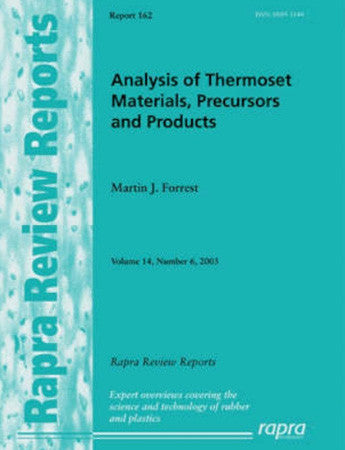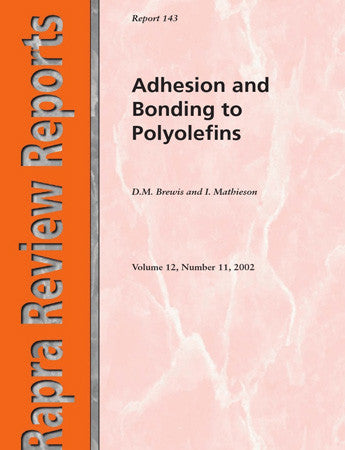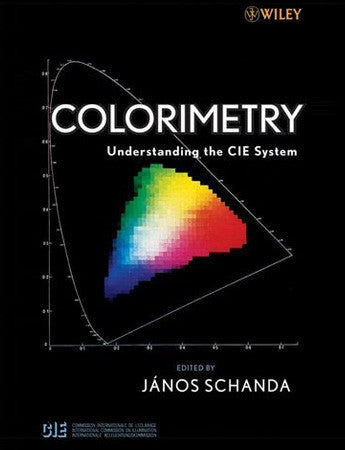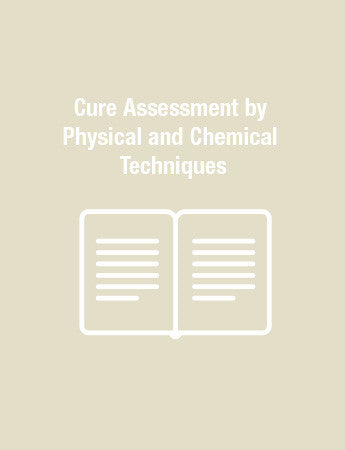Analysis of Thermoset Materials, Precursors and Products.
Thermosets comprise around 25% of world plastic consumption. The use of thermosets dates back over 100 years to the advent of phenolics. Today, a large range of different reactive chemicals is used in the synthesis of these resins. Common thermoset systems include phenol-formaldehyde, melamine-formaldehyde, urea-formaldehyde, resorcinol-formaldehyde, epoxy, polyurethane, polyalkyd, silicone, polyester, acrylic, furan, and polyimide.
A variety of additives are found in thermosets. Plasticizer-type compounds are used to promote the flow of high viscosity compounds such as epoxy resins. Particulate fillers are used to reduce cost or improve properties and fibrous materials for increased strength and rigidity. Other additives include anti-degradants, curing agents (hardeners and accelerators), flame retardants and lubricants.
Thermosets are used in a wide range of applications from moldings and composites to adhesives. Analysis of thermosets is carried out to determine the reasons for failure, for quality control, to measure residual monomer, to detect contaminants, to monitor the extent of cure and for deformulation. Materials based on thermosets present the analyst with considerable challenges due to their complexity and the wide range of polymer types and additives available. The author of this review has many years of experience in the Polymer Analysis division at Rapra Technology Limited. He has a practical understanding of the usefulness and feasibility of the many techniques on offer to the chemist.
Wet chemistry techniques were mainly used historically. One example is the spectrophotometric titration of epoxy groups using a halogen acid and 2,4-dinitrobenzene sulfonate as the chromophore.
Spectroscopic techniques include infrared spectroscopy, ultraviolet, nuclear magnetic resonance, atomic absorption, X-ray fluorescence and Raman spectroscopy.
Chromatographic techniques include gas chromatography-mass spectrometry, HPLC, liquid chromatography-mass spectrometry, gel permeation chromatography, thin layer chromatography and supercritical fluid chromatography.
Thermal techniques used to analyze thermosets include differential scanning calorimetry, dynamic mechanical thermal analysis, thermal mechanical analysis, thermogravimetric analysis and dielectric analysis.
There are many other analytical techniques covered in this review, which describes their specific uses and even set up details for some analytical techniques. The references at the end of the report describe many specific instances of the analysis of thermoset materials published over the last 10 years.
The review is accompanied by around 400 abstracts from papers and books in the Rapra Polymer Library database, to facilitate further reading on this subject. A subject index and a company index are included.
A variety of additives are found in thermosets. Plasticizer-type compounds are used to promote the flow of high viscosity compounds such as epoxy resins. Particulate fillers are used to reduce cost or improve properties and fibrous materials for increased strength and rigidity. Other additives include anti-degradants, curing agents (hardeners and accelerators), flame retardants and lubricants.
Thermosets are used in a wide range of applications from moldings and composites to adhesives. Analysis of thermosets is carried out to determine the reasons for failure, for quality control, to measure residual monomer, to detect contaminants, to monitor the extent of cure and for deformulation. Materials based on thermosets present the analyst with considerable challenges due to their complexity and the wide range of polymer types and additives available. The author of this review has many years of experience in the Polymer Analysis division at Rapra Technology Limited. He has a practical understanding of the usefulness and feasibility of the many techniques on offer to the chemist.
Wet chemistry techniques were mainly used historically. One example is the spectrophotometric titration of epoxy groups using a halogen acid and 2,4-dinitrobenzene sulfonate as the chromophore.
Spectroscopic techniques include infrared spectroscopy, ultraviolet, nuclear magnetic resonance, atomic absorption, X-ray fluorescence and Raman spectroscopy.
Chromatographic techniques include gas chromatography-mass spectrometry, HPLC, liquid chromatography-mass spectrometry, gel permeation chromatography, thin layer chromatography and supercritical fluid chromatography.
Thermal techniques used to analyze thermosets include differential scanning calorimetry, dynamic mechanical thermal analysis, thermal mechanical analysis, thermogravimetric analysis and dielectric analysis.
There are many other analytical techniques covered in this review, which describes their specific uses and even set up details for some analytical techniques. The references at the end of the report describe many specific instances of the analysis of thermoset materials published over the last 10 years.
The review is accompanied by around 400 abstracts from papers and books in the Rapra Polymer Library database, to facilitate further reading on this subject. A subject index and a company index are included.
1. Introduction
2. Thermoset Products
2.1 Thermoset Polymer Systems
2.2 Basic Chemistry
2.3 Additives Used in Thermosets
2.3.1 Organic Modifiers
2.3.2 Fillers
2.3.3 Antidegradants/Stabilisers
2.3.4 Curing Species (e.g., Hardeners and Accelerators)
2.3.5 Flame Retardants
2.3.6 Lubricants
2.3.7 Miscellaneous Additives
3. Overview of Analytical Techniques
3.1 Wet Chemistry Techniques
3.2 Spectroscopic Techniques
3.2.1 Infrared Spectroscopy (IR)
3.2.2 Ultraviolet Light Spectroscopy (UV)
3.2.3 Nuclear Magnetic Resonance Spectroscopy (NMR)
3.2.4 Atomic Absorption Spectroscopy (AAS)
3.2.5 X-Ray Fluorescence Spectroscopy (XRF)
3.2.6 Raman Spectroscopy
3.3 Chromatographic Techniques
3.3.1 Gas Chromatography-Mass Spectrometry (GC-MS)
3.3.2 Gas Chromatography (GC)
3.3.3 High Performance Liquid Chromatography (HPLC)
3.3.4 Liquid Chromatography-Mass Spectroscopy (LC-MS)
3.3.5 Gel Permeation Chromatography (GPC)
3.3.6 Thin Layer Chromatography (TLC)
3.3.7 Supercritical Fluid Chromatography (SFC)
3.4 Thermal Techniques
3.4.1 Differential Scanning Calorimetry (DSC)
3.4.2 Dynamic Mechanical Thermal Analysis (DMTA)
3.4.3 Thermal Mechanical Analysis (TMA)
3.4.4 Thermogravimetric Analysis (TGA)
3.4.5 Dielectric Analysis (DEA)
3.5 Elemental Techniques
3.6 Microscopy Techniques
3.7 Miscellaneous Techniques
4. Characterisation of Thermoset Polymers and their Precursors
4.1 Determination of the Molecular Weight of Thermoset Precursors and the Separation of their Oligomers
4.1.1 Gel Permeation Chromatography
4.1.2 Liquid Chromatography Techniques
4.1.3 Epoxy Resins
4.1.4 Polyurethane
4.1.5 Microbore-GPC
4.1.6 Other Techniques
4.2 Polymer Type and Microstructure
4.2.1 Infrared Spectroscopy
4.2.2 NMR Spectroscopy
4.2.3 Identifying Functional Groups
4.2.4 Pyrolysis Gas Chromatography
4.2.5 Thermal Analysis Techniques
5. Determination of Organic Modifiers and Fillers in Thermoset Products
5.1 Determination of Organic Modifiers
5.2 Determination of Fillers
5.2.1 Particulate Fillers
5.2.2 Fibrous Fillers
6. Determination of Functional Additives in Thermoset Products
6.1 Antidegradants
6.2 Flow Promoters and Flexibilisers
6.3 Pigments
6.4 Blowing Agents
6.5 Flame Retardants
6.6 Curing Systems
7. Cure Behavior Studies
7.1 Dielectric Analysis
7.2 Differential Scanning Calorimetry
7.3 Dynamic Mechanical Thermal Analysis/Dynamic Mechanical Analysis
7.4 Thermal Mechanical Analysis
7.5 Scanning Vibrating Needle Curemeter
7.6 Chromatography Techniques
7.7 Spectroscopy Techniques
7.8 Thermally Stimulated Depolarisation
7.9 Wet Chemistry Techniques
8. Surface Analysis of Thermosets
8.1 X-Ray Photoelectron Spectroscopy (XPS)
8.2 Laser Induced Mass Analysis (LIMA)
8.3 Secondary Ion Mass Spectroscopy (SIMS)
9. Failure Diagnosis
9.1 Compositional Problems
9.2 Heat Ageing
9.3 Contamination Problems
9.3.1 Solid Contaminants
9.3.2 Liquid Contaminants
9.4 Odor and Emissions Problems
10.Conclusion
2. Thermoset Products
2.1 Thermoset Polymer Systems
2.2 Basic Chemistry
2.3 Additives Used in Thermosets
2.3.1 Organic Modifiers
2.3.2 Fillers
2.3.3 Antidegradants/Stabilisers
2.3.4 Curing Species (e.g., Hardeners and Accelerators)
2.3.5 Flame Retardants
2.3.6 Lubricants
2.3.7 Miscellaneous Additives
3. Overview of Analytical Techniques
3.1 Wet Chemistry Techniques
3.2 Spectroscopic Techniques
3.2.1 Infrared Spectroscopy (IR)
3.2.2 Ultraviolet Light Spectroscopy (UV)
3.2.3 Nuclear Magnetic Resonance Spectroscopy (NMR)
3.2.4 Atomic Absorption Spectroscopy (AAS)
3.2.5 X-Ray Fluorescence Spectroscopy (XRF)
3.2.6 Raman Spectroscopy
3.3 Chromatographic Techniques
3.3.1 Gas Chromatography-Mass Spectrometry (GC-MS)
3.3.2 Gas Chromatography (GC)
3.3.3 High Performance Liquid Chromatography (HPLC)
3.3.4 Liquid Chromatography-Mass Spectroscopy (LC-MS)
3.3.5 Gel Permeation Chromatography (GPC)
3.3.6 Thin Layer Chromatography (TLC)
3.3.7 Supercritical Fluid Chromatography (SFC)
3.4 Thermal Techniques
3.4.1 Differential Scanning Calorimetry (DSC)
3.4.2 Dynamic Mechanical Thermal Analysis (DMTA)
3.4.3 Thermal Mechanical Analysis (TMA)
3.4.4 Thermogravimetric Analysis (TGA)
3.4.5 Dielectric Analysis (DEA)
3.5 Elemental Techniques
3.6 Microscopy Techniques
3.7 Miscellaneous Techniques
4. Characterisation of Thermoset Polymers and their Precursors
4.1 Determination of the Molecular Weight of Thermoset Precursors and the Separation of their Oligomers
4.1.1 Gel Permeation Chromatography
4.1.2 Liquid Chromatography Techniques
4.1.3 Epoxy Resins
4.1.4 Polyurethane
4.1.5 Microbore-GPC
4.1.6 Other Techniques
4.2 Polymer Type and Microstructure
4.2.1 Infrared Spectroscopy
4.2.2 NMR Spectroscopy
4.2.3 Identifying Functional Groups
4.2.4 Pyrolysis Gas Chromatography
4.2.5 Thermal Analysis Techniques
5. Determination of Organic Modifiers and Fillers in Thermoset Products
5.1 Determination of Organic Modifiers
5.2 Determination of Fillers
5.2.1 Particulate Fillers
5.2.2 Fibrous Fillers
6. Determination of Functional Additives in Thermoset Products
6.1 Antidegradants
6.2 Flow Promoters and Flexibilisers
6.3 Pigments
6.4 Blowing Agents
6.5 Flame Retardants
6.6 Curing Systems
7. Cure Behavior Studies
7.1 Dielectric Analysis
7.2 Differential Scanning Calorimetry
7.3 Dynamic Mechanical Thermal Analysis/Dynamic Mechanical Analysis
7.4 Thermal Mechanical Analysis
7.5 Scanning Vibrating Needle Curemeter
7.6 Chromatography Techniques
7.7 Spectroscopy Techniques
7.8 Thermally Stimulated Depolarisation
7.9 Wet Chemistry Techniques
8. Surface Analysis of Thermosets
8.1 X-Ray Photoelectron Spectroscopy (XPS)
8.2 Laser Induced Mass Analysis (LIMA)
8.3 Secondary Ion Mass Spectroscopy (SIMS)
9. Failure Diagnosis
9.1 Compositional Problems
9.2 Heat Ageing
9.3 Contamination Problems
9.3.1 Solid Contaminants
9.3.2 Liquid Contaminants
9.4 Odor and Emissions Problems
10.Conclusion
Dr. Martin Forrest has worked in the Polymer Analysis Section at Rapra for fifteen years. He is currently a Principal Consultant, a position he has held for the past four years. He has experience in the analysis of a wide variety of polymers and polymer products using an extensive range of techniques. He is one of the main contacts at Rapra for consultancy and research projects that involve polymer analysis techniques and procedures.




